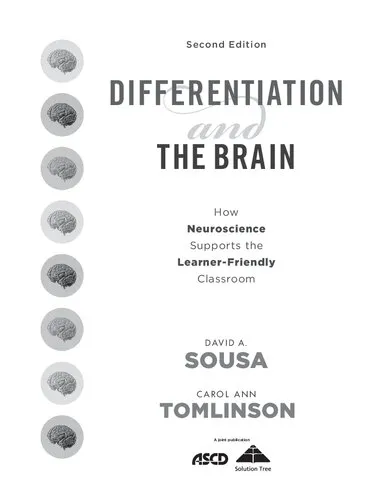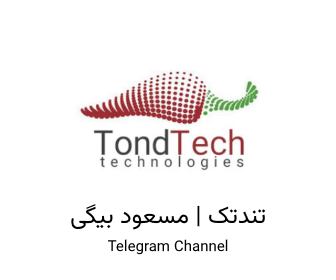Differentiation and the Brain: How Neuroscience Supports the Learner-Friendly Classroom
4.3
بر اساس نظر کاربران

شما میتونید سوالاتتون در باره کتاب رو از هوش مصنوعیش بعد از ورود بپرسید
هر دانلود یا پرسش از هوش مصنوعی 2 امتیاز لازم دارد، برای بدست آوردن امتیاز رایگان، به صفحه ی راهنمای امتیازات سر بزنید و یک سری کار ارزشمند انجام بدینمعرفی کتاب «Differentiation and the Brain: How Neuroscience Supports the Learner-Friendly Classroom»
کتاب «Differentiation and the Brain» نوشته دیوید ای. سوسا و کرول آن تاملینسون، یکی از منابع گرانبها برای تمامی معلمان، مربیان و علاقهمندان به یادگیری و آموزش است. این کتاب با بهرهگیری از تحقیقات و یافتههای پیشرفته علوم مغز و اعصاب، به بررسی موضوعات کلیدی در مورد ایجاد کلاسهای یادگیرندهمحور و شیوههای متنوع تدریس میپردازد. هدف نویسندگان این کتاب آن است که نشان دهند چگونه معلمان میتوانند استراتژیهای Differentiation را با یافتههای علمی در مورد مغز پیوند بزنند تا تجربه یادگیری دانشآموزان بهینه شود.
خلاصهای جامع از کتاب
این کتاب چرایی و چگونگی Differentiation در کلاس درس را توضیح میدهد و این مفهوم را در چارچوب تحقیقات علمی با تمرکز بر مغز بیان میکند. نویسندگان به بررسی مفصلی از موضوعاتی چون انعطافپذیری عصبی (neuroplasticity)، حافظه، توجه، و تأثیر احساسات در فرآیند یادگیری پرداختهاند. با استفاده از مثالهای واقعی و سناریوهای قابلاستفاده، این کتاب راهکارهای عملی به معلمان ارائه میدهد تا دانشآموزانی با زمینههای متفاوت را بهتر در فرآیند یادگیری مشارکت دهند. همچنین، نویسندگان تاکید دارند که روشهای Differentiation نه تنها برای دانشآموزان مفید است، بلکه باعث رشد حرفهای و شخصی معلمان نیز میشود.
یادگیریهای کلیدی از کتاب
- درک ارتباط بین Neuroscience و Differentiation
- چگونگی استفاده از انعطافپذیری عصبی برای کمک به دانشآموزان مختلف
- استفاده از عوامل عاطفی و انگیزشی در فرآیند تدریس
- راهکارهای علمی برای تقویت حافظه و توجه
- نحوه طراحی فعالیتها و ارزیابیهای متنوع برای پاسخ به نیازهای یادگیری گوناگون
نقلقولهای معروف از کتاب
- "Differentiation is not a set of strategies. It’s a way of thinking about teaching and learning."
- "Understanding how the brain learns can transform how we teach."
- "The goal of Differentiation is to respect the uniqueness of every learner in the classroom."
اهمیت این کتاب
کتاب «Differentiation and the Brain» به دلیل رویکرد علمی و کاربردی خود مورد توجه بسیاری از معلمان و متخصصان آموزش قرار گرفته است. اهمیت این کتاب در این است که به معلمان نشان میدهد چگونه با استفاده از یافتههای علمی محیط یادگیریای ایجاد کنند که مناسب نیازهای فردی دانشآموزان باشد. همچنین، این کتاب یک نقشه راه جامع برای ادغام علوم مغز و اعصاب در کلاسهای یادگیرندهمحور ارائه میدهد. علاوه بر این، کتاب تاکید میکند که تدریس مؤثر نیازمند درک عمیق از مغز و روشهای یادگیری گوناگون است. از این رو، میتوان گفت این کتاب مسیری برای بهبود کیفیت آموزش و یادگیری در مدارس امروز است.
Welcome to "Differentiation and the Brain: How Neuroscience Supports the Learner-Friendly Classroom," an essential guide that bridges the gap between neuroscience research and practical application in differentiated instruction. Authored by David A. Sousa and Carol Ann Tomlinson, this book provides educators with evidence-based strategies to create effective, brain-friendly classrooms that address the diverse learning needs of all students.
Detailed Summary of the Book
At its core, Differentiation and the Brain is about the intersection of neuroscience and education. The book dives deep into the principles of differentiation—a pedagogical approach where instruction is tailored to meet the varying needs of each learner in the classroom. Sousa and Tomlinson demonstrate how incorporating knowledge of how the brain learns can enhance differentiation efforts, making lessons more engaging, impactful, and effective for students of all backgrounds and abilities.
The authors explain crucial brain processes, including memory, information retrieval, and neural connections, and link these to instructional strategies that teachers can use. The text is structured around three core themes: why differentiation is necessary; how neuroscience supports the concept; and practical ways to apply it in teaching and assessment. Each chapter pairs scientific research with relatable examples from the classroom, ensuring that educators understand not only the 'what' and 'why' but also the 'how' of differentiated instruction.
With insights into topics such as student readiness, interest, and learning profiles, the book provides a roadmap for creating learning environments where each student thrives. It also discusses the challenges teachers face with differentiation and offers practical steps to overcome these hurdles.
More than just theory, Differentiation and the Brain is loaded with actionable strategies educators can implement immediately. The book ensures that teachers understand how differentiation isn't just a goal—it's an attainable, transformative practice that aligns with how the brain learns best.
Key Takeaways
- Differentiated instruction is essential for meeting the diverse needs of students in today's classrooms.
- Neuroscience supports differentiation by showing how the brain processes, stores, and retrieves information uniquely for each learner.
- Strategies such as flexible grouping, tiered assignments, and student choice align with brain-based learning principles.
- Differentiation is not a one-size-fits-all solution; it requires ongoing adjustments based on student readiness, interest, and learning profiles.
- Teachers play a vital role in cultivating a growth mindset and a positive, risk-free classroom climate for optimal learning.
Famous Quotes from the Book
"A differentiated classroom is not a mathematical formula for teachers to apply but an organic process they can cultivate."
"Learning relies on both the teacher’s ability to differentiate instruction and the brain’s ability to adapt and grow."
"If every brain is unique, then every student deserves a learning journey tailored to their strengths and needs."
Why This Book Matters
In an educational landscape where diversity in learning abilities, backgrounds, and interests is the norm, this book is a critical resource for modern classrooms. It highlights the synergy between brain science and instructional design, showing educators how to align teaching methods with how students learn naturally. By combining the latest research with practical tools, Sousa and Tomlinson inspire teachers to rethink their approaches to instruction, ensuring that lessons are adaptable, inclusive, and impactful.
This book matters because it empowers educators to address the gaps in learning with confidence, supported by both science and proven methods. At a time when classrooms are more diverse than ever before, the tools and insights offered by Differentiation and the Brain are invaluable for fostering equity and academic success across the board.
Ultimately, Differentiation and the Brain represents more than a teaching strategy; it’s a mindset shift. It challenges us to see each student as capable of extraordinary growth and achievement, provided they are given the right opportunities to learn in ways that match their unique brains.
دانلود رایگان مستقیم
برای دانلود رایگان این کتاب و هزاران کتاب دیگه همین حالا عضو بشین
برای خواندن این کتاب باید نرم افزار PDF Reader را دانلود کنید Foxit Reader


